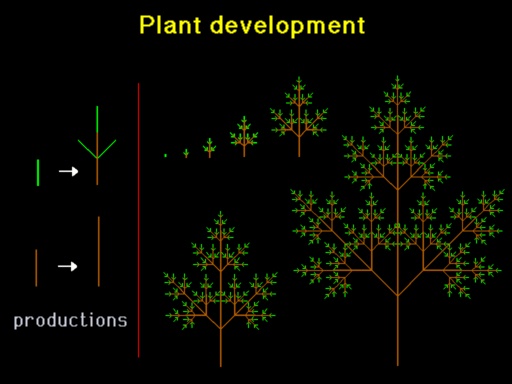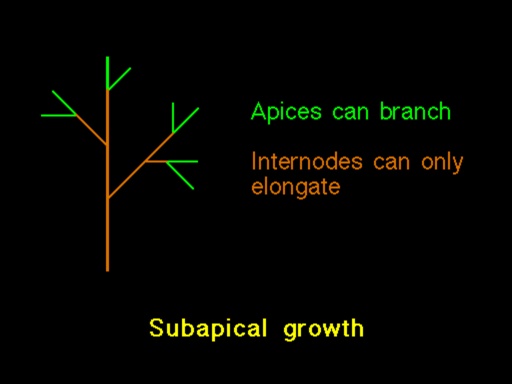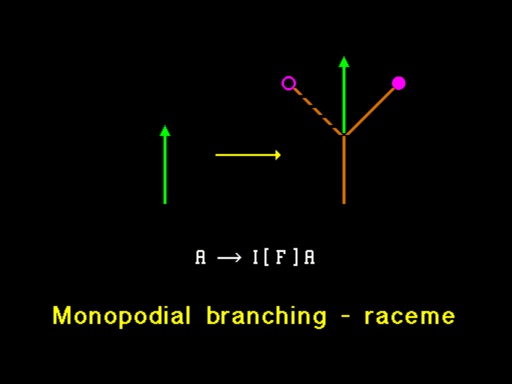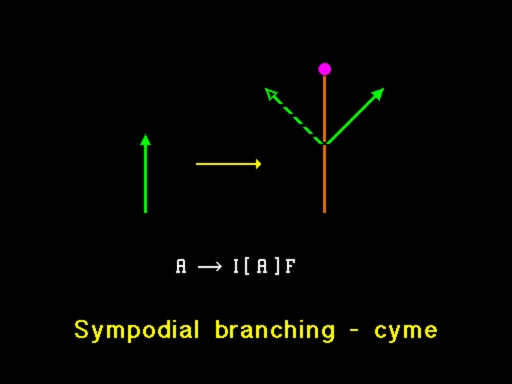In spite of its simplicity, the simple model of a compound
leaf shown in
Plate 13
properly reflects one of the general principles of the development of higher
plants.

It is called the principle of subapical growth,
and means that only apices can create new branches. Internodes may elongate,
but cannot initiate branches. These rules are illustrated schematically
in
Plate 14.
 A variety of structures can be produced
through subapical growth, depending on which apices remain active and initiate
new branches, and which ones do not. In line with the research interests
of Lindenmayer and other biologists using L-systems, this section focuses
on the modeling and simulation of the inflorescences of herbaceous plants.
For a more complete description see Chapter 3 of [Pru1990]
A variety of structures can be produced
through subapical growth, depending on which apices remain active and initiate
new branches, and which ones do not. In line with the research interests
of Lindenmayer and other biologists using L-systems, this section focuses
on the modeling and simulation of the inflorescences of herbaceous plants.
For a more complete description see Chapter 3 of [Pru1990]
The simplest case occurs when only the apex of the main
axis of the growing plant produces new branches, as shown in
Plate 15.
 These lateral branches carry buds and
then flowers, but do not branch any further. The resulting structure is
called a monopodial branching structure, and the corresponding
inflorescence is called a raceme.
Plate 16
illustrates the
development of a common weed Capsella bursa-pastoris, or shepherd's
purse, following this principle.
These lateral branches carry buds and
then flowers, but do not branch any further. The resulting structure is
called a monopodial branching structure, and the corresponding
inflorescence is called a raceme.
Plate 16
illustrates the
development of a common weed Capsella bursa-pastoris, or shepherd's
purse, following this principle.

The creeping bellflower Campanula rapunculoides,
presented in
Animation 9,
develops in the same manner.
Additional views of this development are included in
Animation 10,
which combines models of several plants in a single scene, and
Animation 11,
which presents a view of the flowers.
 Plate 17
shows a form of branching
which, in a sense, is opposite to the previous one. In this case, called
sympodial branching, the apex produces a flower bud terminating
the development of the current axis, but in addition produces one or more
active lateral apices. This process repeats recursively, with the main thrust
of the development always going into the lateral branches.
Plate 17
shows a form of branching
which, in a sense, is opposite to the previous one. In this case, called
sympodial branching, the apex produces a flower bud terminating
the development of the current axis, but in addition produces one or more
active lateral apices. This process repeats recursively, with the main thrust
of the development always going into the lateral branches.
The resulting inflorescence type is called a cyme.
The development of Lychnis coronaria, or rose campion, shown in
Animation 12
and
Animation 13,
provides a good example of the described process.
Animation 14
presents a view of the development of a single flower.
Yet another branching type, called polypodial
branching, is presented schematically in
Plate 18.
 In this case, both the apex of the main
axis and the lateral apices produce new branches until, at some point in
time, the apices undergo a developmental switch and are transformed into
flower buds. The resulting inflorescence, called a panicle, may
adopt various forms depending on the geometric parameters. In this case, both the apex of the main
axis and the lateral apices produce new branches until, at some point in
time, the apices undergo a developmental switch and are transformed into
flower buds. The resulting inflorescence, called a panicle, may
adopt various forms depending on the geometric parameters.
For example,
Plate 19) shows a so-called decussate
branching pattern, in which pairs of lateral branches are arranged in mutually
perpendicular planes.

By terminating each of these branches with a flower we
can model lilac inflorescences, as presented in
Plate 20.
 |